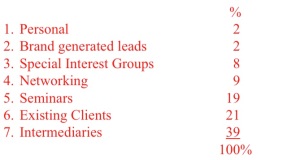How One Successful Financial Planner Gets New Business (part 2)





 Professionals are always interested in what other professionals are doing that leads to new business and becoming more successful. The constant question is:
Professionals are always interested in what other professionals are doing that leads to new business and becoming more successful. The constant question is:
In a previous post one leading financial planner shared where he gets his new business from, and the biggest proportion by far is from professional referrals – that is, other advisers referring clients to him. This planner knows he is a specialist in his field, and works very hard to be a good specialist. He knows that other professionals have their own areas of expertise but are working with his ideal clients too, so he focusses upon building the right relationships with those other professionals so that they become his Centres-Of-Influence (COI’s) as they can drive his new business requirements for him.
To recap, this is where the Financial Planner obtains his new business:

His tips on how to make it work:
A good COI who is a fellow adviser provides 3-4 quality referrals per year, and an Advocate provides 5+ referrals p.a. Finding and developing these relationships is primarily done through active involvement in the advisers professional body, especially at local branch (regional) level; getting known and involved in special interest groups at other professional associations (e.g. Chartered Accountant’s professional body); Rotary and BNI (Business Networking Group). So an active involvement in professional and community groups building the reputation and position creates COI opportunities.
When it is time to take the personal relationship which has developed into a strong rapport with the other professional and have a serious business meeting about the prospects of generating professional introductions, the meeting process is quite structured – no matter how strong the existing rapport and understanding of the objectives are.
The Financial Planner covers the following at the first “formal” meeting:
At this point he knows whether he has a good COI (or prospective COI) or whether to “abort the mission” (and that is the phrase he uses incidentally).
If it is a good COI then there is a timetabled and diarised process to ensure that the right amount of time is being invested in the COI relationship. Regular contact by phone which is aimed at providing something useful to them, and finding out a little more each time about their personal world builds the relationship. This is supplemented by physically visiting the COI and their business several times per year to get a feel for their world, and to create visibility. This “in person” contact works on a 90 day cycle, whereas the phone contact together with providing useful/relevant content via email runs on about a 3-4 week cycle. Over and above this contact process he tries to find ways to provide or run workshops for the COI’s clients, and run small functions where each can meet each others ideal clients.
Little is left to chance.
There is a clear strategy on how to develop the right COI’s and this is supported by an organised approach and systematic contact system. All of this is supported by constant delivery of value added services that focus on delivering quality information that educates and informs.
It takes some organisation and time to develop the resources and relationships – but they pay off. Over half of the new business generated in any given year is coming from professional networking efforts, and a further 19% from running seminars. There is little reliance upon having to mine existing clients for the last available dollar, and the reality is the majority of clients invest fully via the planner to begin with – so there is little that is “held back” when the client has been successfully engaged.
That is how one successful adviser does it.
You may also find this post useful:
Comments (1)